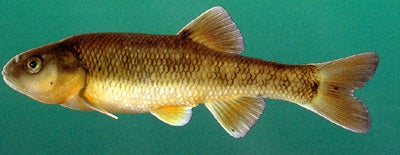DIXIE CHUB
SCIENTIFIC NAME: Semotilus thoreauianus
CHARACTERISTICS: The Dixie chub, whose body form resembles that of the creek chub, Semotilus atromaculatus, is generally shorter and more robust, with larger scales and less distinct dorsal and caudal spots. Breeding males have four large, hooked tubercles on each side of the head, with the tubercles nearest the nares often being fused. Body color is generally dark above, with orange to pink on the underside, and fins are yellow-orange. The Dixie chub is distinguishable from S. atromaculatus by having fewer head tubercles on the gill covers and caudal fin, and a diffuse spot at the caudal fin base. The spot is typically wedge-shaped and separated from the lateral band, whereas the caudal spot in S. atromaculatus is quadrate-shaped and connected to the lateral band. See Jordan (1877b) for original description and Johnston and Ramsey (1990) for a recent redescription.
ADULT SIZE: 2.6 to 5.9 in (65 to 150 mm)
DISTRIBUTION: Semotilus thoreauianus is found in Gulf slope drainages from the Mobile basin east to the Ochlockonee River drainage in Georgia. It occurs sympatrically with S. atromaculatus throughout the Mobile basin, primarily below the Fall Line, and replaces it in coastal drainages from the Conecuh east to the Chattahoochee. Our collections of Dixie chubs from the three Bear Creek tributaries in Colbert County represent the first records of this species in the Tennessee River drainage.
HABITAT AND DISTRIBUTION: The Dixie chub prefers headwater streams with riffles and flowing pools over sandy or soft substrates. Spawning aggregations were observed in April in a sandy tributary to Mahan Creek in the Cahaba River. R.D. Suttkus"s field notes from March 1950 record the collection of a tuberculate male guarding a nest of small, hard clay pieces and located in the Omussee Creek, a Chattahoochee tributary in Houston County. Woolcott and Maurakis (1988) report nest located in the tails of pools with nearby cryptic refugial. A single male constructed each pit excavation created the ridge. The Dixie chub is an omnivore, consuming a variety of animal and plant foods, including insects, worms, fishes, mollusks, crayfishes, and plant material.
ORIGINAL DESCRIPTION: The Dixie chub was described by Jordan in 1877.
ETYMOLOGY:
Semotilus means spotted banner, referring to the dorsal fin.
Thoreauianus means in honor of Henry David Thoreau.
The copyrighted information above is from Fishes of Alabama and the Mobile Basin.






